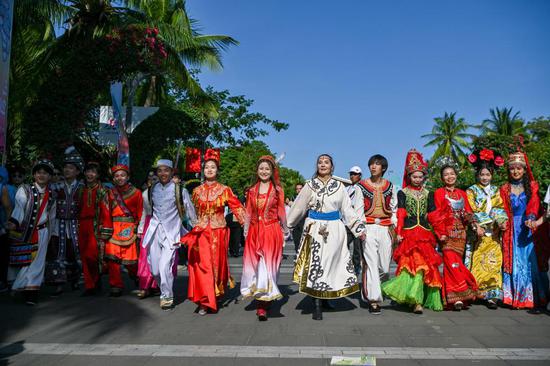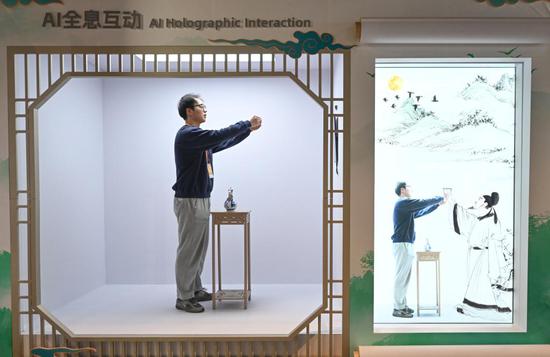Legal revision ensures protection of nation's many ungraded sites
The newly revised Law on Protection of Cultural Relics will take effect on March 1, guiding the protection and management of these precious items to better meet the requirements of the new era and give cultural heritage a new lease of life, experts and officials said.
On Nov 8, the revision was passed by the Standing Committee of the National People's Congress, China's top legislature. It's the second revision since the law was implemented in 1982, following the first in 2002.
According to Liang Ying, an official from the NPC Standing Committee's Legislative Affairs Commission, as the first law focusing on the cultural field since the founding of New China, the Law on Protection of Cultural Relics has played a significant role in enhancing the protection of cultural relics, preserving outstanding historical and cultural heritage, promoting scientific research, and building a socialist spiritual and material civilization.
"In the new era, our work related to cultural relics faces new situations and tasks.... To meet the needs of the development of the cultural relics sector, it was necessary to revise the law," he said.
Highlights of the newly revised law include enhanced requirements for protecting ungraded immovable cultural heritage sites, which weren't clearly covered in the past.
According to the third national census on cultural relics in China from 2007-11, the country boasts more than 766,000 immovable cultural heritage sites, among which only 150,000 have been listed as sites protected at the national, provincial, city or county levels, accounting for only 20 percent.
That means 80 percent of them remain ungraded. They are numerous, diverse and widely distributed. Without clear laws or regulations on their protection, in the past there were many cases of damage and destruction of such sites in urban renewal projects, said Zhu Bing, a retired official of the NPC's Education, Science, Culture and Public Health Committee.
Wang Yunxia, director of the Institute of Cultural Heritage Law affiliated to the Law School of Renmin University of China, said the revision makes the stipulations of the law clearer.
"The law this time makes it clear that the ungraded immovable sites also need strong and effective protection and lists detailed protection efforts required. These provisions are expected to thoroughly rectify the previous legal deficiencies in this area," Wang said.
Another highlighted revision is the substantial increase in the administrative penalties for destroying cultural relics. The maximum fine for damaging cultural heritage items has been raised from 500,000 yuan ($68,900) to 10 million yuan.
"The 500,000 yuan limit was established in the 2002 revision. Since then, more than two decades have passed, and GDP has grown significantly. The previous limit no longer serves as a deterrent for many illegal construction outfits, which would rather pay the fine and continue their work. Raising the fine to 10 million yuan can now effectively deter many of them," said Wang.
"In the past, some people said the Law on Protection of Cultural Relics was 'toothless' due to its lenient penalties. Now, with the increased fines, lawbreakers will feel the consequences. This is a key point in our revision," she added.
Lin Yongwei, a grassroots cultural heritage professional dedicated to protecting the Erlitou Site, widely believed to be a late capital of the Xia Dynasty (c. 21st century-16th century BC) in Luoyang, Henan province, has been closely following the law and its developments.
"Not only myself, but all grassroots workers engaged with the protection and management of cultural heritage have been paying close attention to the revision. We have expected the law would address many of the issues in our work," said Lin.
He said the inclusion of the statement about "bringing cultural relics back to life" particularly encouraged him, as he and his colleagues are working to build an archaeological ruins park around Erlitou.
"It's so related to our daily work. Now we can build an archaeological ruins park, which is a way to make better use of cultural relics. The law consolidates our resolution and confidence to promote the innovative and high-quality development of the park and makes it clear that our task is to provide diverse cultural products and services to the public," said Lin.
"The articles within the law also work as legal references for our practices such as developing cultural relics-themed tourism, archaeological study tours and integrating cultural heritage into agricultural tourism. I believe cultural heritage administrations at different levels will introduce more policies benefiting their development," he added.
According to Wang, the new law promotes the "effective utilization" of cultural relics with detailed regulations on how to better use them, which transcends the stress of "reasonable utilization" in the 2002 version of the law.
"The earlier law focused primarily on the protection and management of cultural heritage. The revised law, however, encourages its utilization and sets higher standards and requirements for effective use, while establishing clear boundaries to prevent overuse," said Wang.
Both Wang and Lin highlighted the newly added article that encourages public participation in the protection of cultural relics.
Wang said: "Cultural heritage exists as a testament to the history of a nation. Therefore, the protection of it is not only the responsibility of the government or specialized institutions but also a matter for the public. Encouraging public participation in cultural heritage protection can lead to a greater understanding of cultural heritage and its value. This, in turn, can foster a deeper awareness and appreciation of cultural relics protection, leading to a stronger commitment to preserving them."
Many people have the ability to protect cultural relics, said Wang, adding that they can establish funds, build private museums and work as volunteers protecting heritage sites.
She said the government should provide more support for such practices and encourage the public to join the cause.


















































 京公网安备 11010202009201号
京公网安备 11010202009201号